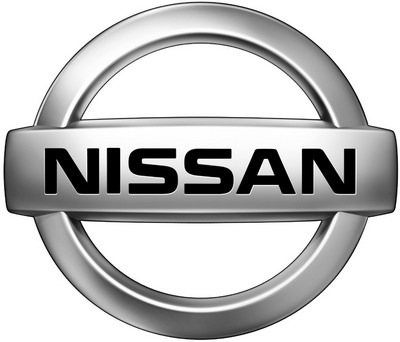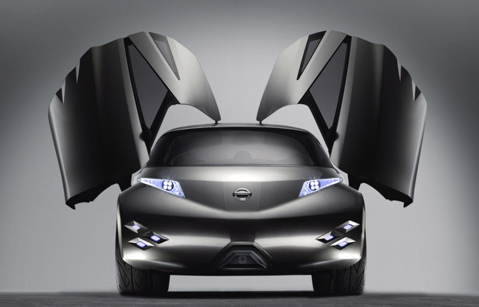Nissan Motor Company Ltd (Japanese: , Nissan Jidōsha Kabushiki-gaisha?) (TYO: 7201), usually shortened to Nissan ( /ˈniːsɑːn/ or UK /ˈnɪsæn/; Japanese: [nisːaɴ]), is a multinational automaker headquartered in Japan. It was formerly a core member of the Nissan Group, but has become more independent after its restructuring under Carlos Ghosn (CEO).
It formerly marketed vehicles under the "Datsun" brand name and is one of the largest car manufacturers in the world. As of 2011, the company's global headquarters is located in Nishi-ku, Yokohama. In 1999, Nissan entered a two way alliance with Renault S.A. of France, which owns 43.4% of Nissan while Nissan holds 15% of Renault shares, as of 2008. The current market share of Nissan, along with Honda and Toyota, in American auto sales represent the largest of the automotive firms based in Asia that have been increasingly encroaching on the historically dominant US-based "Big Three" consisting of GM, Ford and Chrysler. In its home market, Nissan became the second largest car manufacturer in 2011, surpassing Honda with Toyota still very much the dominant first. Along with its normal range of models, Nissan also produces a range of luxury models branded as Infiniti.
The Nissan VQ engines, of V6 configuration, have been featured among Ward's 10 Best Engines for 14 straight years.
It was renamed to Kwaishinsha Motorcar Co. in 1918, and again to DAT Motorcar Co. in 1925. DAT Motors built trucks in addition to the DAT and Datsun passenger cars. The vast majority of its output were trucks, due to an almost non-existent consumer market for passenger cars at the time. Beginning in 1918, the first DAT trucks were produced for the military market. It was the low demand of the military market in the 1920s that forced DAT to merge in 1926 with Japan's 2nd most successful truck maker, Jitsuyo Motors.
In 1926 the Tokyo-based DAT Motors merged with the Osaka-based Jitsuyo Jidosha Co., Ltd. , Jitsuyō Jidōsha Seizō Kabushiki-Gaisha?) a.k.a. Jitsuyo Motors (established 1919, as a Kubota subsidiary) to become DAT Automobile Manufacturing Co., Ltd. , Datto Jidōsha Seizō Kabushiki-Gaisha?) in Osaka until 1932.
In 1931, DAT came out with a new smaller car, the first "Datson", meaning "Son of DAT". Later in 1933 after Nissan took control of DAT Motors, the last syllable of Datson was changed to "sun", because "son" also means "loss" in Japanese, hence the name "Datsun" , Dattosan?).
In 1928, Yoshisuke Aikawa founded the holding company Nippon Sangyo (Japan Industries or Nippon Industries). "The name 'Nissan' originated during the 1930s as an abbreviation"[4] used on the Tokyo stock market for Nippon Sangyo. This company was the famous Nissan "Zaibatsu" (combine) which included Tobata Casting and Hitachi. At this time Nissan controlled foundries and auto parts businesses, but Aikawa did not enter automobile manufacturing until 1933.
Nissan would eventually grow to include 74 firms, and to be the fourth-largest combine in Japan during World War II.
In 1930, Aikawa purchased controlling(?) shares in DAT Motors, and then in 1933 it merged Tobata Casting's automobile parts department with DAT Motors. As Tobata Casting was a Nissan company, this was the beginning of Nissan's automobile manufacturing.
In 1934, Aikawa "separated the expanded automobile parts division of Tobata Casting and incorporated it as a new subsidiary, which he named Nissan Motor (Nissan)". Nissan Motor Co., Ltd. (日産自動車, Nissan Jidōsha?). The shareholders of the new company however were not enthusiastic about the prospects of the automobile in Japan, so Aikawa bought out all the Tobata Casting shareholders (using capital from Nippon Industries) in June, 1934. At this time Nissan Motors effectively became owned by Nippon Sangyo and Hitachi.
Nissan built trucks, airplanes, and engines for the Japanese military. The company's main plant was moved to China after land there was captured by Japan. The plant made machinery for the Japanese war effort until it was captured by American and Russian forces. From 1947 to 1948 the company was called Nissan Heavy Industries Corp.
DAT had inherited Kubota's chief designer, American William R. Gorham. This, along with Aikawa's inspiring 1908 visit to Detroit, was to greatly affect Nissan's future.
Although it had always been Aikawa's intention to use cutting-edge auto making technology from America, it was Gorham that carried out the plan. All the machinery, vehicle designs and engine designs originally came out of the United States. Much of the tooling came from the Graham factory and Nissan had a Graham license under which trucks were made. The machinery was imported into Japan by Mitsubishi[9] on behalf of Nissan, which went into the first Yokohama factory to produce cars.
In early 1950s, Nissan partnered with an established European company to gain access to up-to-date automobile and engine designs. Nissan chose Austin of the United Kingdom, which later became the British Motor Corporation by its merger with Morris et al. Nissan began building Austin 7s in 1930, though the legitimacy of their license at that time is debated. After the success of Nissan, Hino and Isuzu followed to partner with Renault and Hillman respectively.
In 1952 Nissan Motor Company of Japan entered into a legal agreement with Austin ,[11] for Nissan to assemble 2,000 Austins from imported partially assembled sets and sell them in Japan under the Austin trademark. The agreement called for Nissan to make all Austin parts locally within three years, a goal Nissan met. Nissan produced and marketed Austins for seven years. The agreement also gave Nissan rights to use Austin patents, which Nissan used in developing its own engines for its Datsun line of cars. In 1953 British-built Austins were assembled and sold, but by 1955, the Austin A50 – completely built by Nissan and featuring a slightly larger body with new 1489 cc engine—was on the market in Japan. Nissan produced 20,855 Austins from 1953–1959.
Nissan leveraged the Austin patents to further develop their own modern engine designs past what the Austin's A- and B-family designs offered. The apex of the Austin-derived engines was the new design A series engine in 1967. Also in 1967 Nissan introduced its new highly advanced four cylinder overhead cam (OHC) Nissan L engine, which while similar to Mercedes-Benz OHC designs was a totally new engine designed by Nissan. This engine powered the new Datsun 510, which gained Nissan respect in the worldwide sedan market. Then, in 1969 Nissan introduced the Datsun 240Z sports car which used a six-cylinder variation of the L series engine. The 240Z was an immediate sensation and lifted Nissan to world class status in the automobile market.








No comments:
Post a Comment